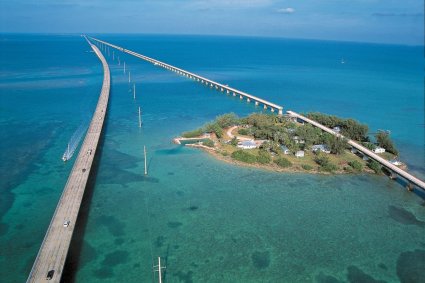US state of Florida
Florida is a state in the southeast United States. It is a peninsula, which means that water surrounds the state on three of four possible sides. To the west is the Gulf of Mexico, to the south is the Florida Straits, and to the east is the Atlantic Ocean. As of 2010, the population of Florida is 18,801,310.
Florida is a very flat state. It has no mountains. Northern Florida has hills because it is at the very end of the Appalachian Mountains. The highest hill in Florida is Britton Hill, in northern Walton County near the town of Lakewood, Florida. It is 345 feet above sea level. It is the shortest of the highest points in all other states.
Florida has a very long coastline, which means lots of beaches. The Gulf Stream ocean current goes through the Atlantic Ocean near the east coast of Florida, so the water there is very warm compared to the Pacific Ocean. The Gulf of Mexico on the west coast of Florida is also very warm because it is small and easily heated by the sun.
In the center of southern Florida is a very big lake called Lake Okeechobee. It is the seventh largest freshwater lake in the United States and the second largest freshwater lake entirely within the lower 48 states. Okeechobee is 730 square miles (1,890 km²), about half the size of the state of Rhode Island, and is very shallow for a lake of its size, with an average depth of only 9 feet (3 m).
A lot of south Florida used to be covered by a swamp called the Everglades. When Florida was first being settled, farmers found out the soil there was very good for growing plants. So they could use more of the land to plant, they drained a lot of the water away in 1882. In 1947, the state put in levees and canals to make more room for farming and houses. The Everglades is now about half the size it used to be. Most of what is left is now the Everglades National Park. Lots of animals live there, including alligators and Florida panthers. Recently, Florida has been trying to restore the Everglades.
Florida is the Sunshine State. The reason for this nickname is its warm temperature. During the summer, temperatures may rise up to as high as 109 degrees Fahrenheit (or 40.5 degrees Celsius). Its average temperature is much warmer than many of the other states, but during winter, temperatures occasionally fall below 32 degrees Fahrenheit. In Florida there are many palm trees. Palm trees grow in places that have a warm climate and a lot of sunshine. Florida has both a rainy season and a dry season. Southern Florida does not have four separate seasons.
Florida's sunny climate is very popular with visitors. The summer is great for surfing the waves and enjoying the beaches. The most popular sport in Florida is fishing. A lot of people also like to visit the beaches on the west side of Florida, near Tampa.
From Wikipedia, the free encyclopedia


Education in Florida
There are ten public universities and a liberal arts college that comprise the State University System of Florida. In addition the Florida College System comprises 28 public community colleges and state colleges. In 2008 the State University System had 302,513 students. Florida also has many private universities, some of which comprise the Independent Colleges and Universities of Florida. In 2010, nineteen of Florida's 28 community colleges were offering four year degree programs.
The state's public primary and secondary schools are administered by the Florida Department of Education (FLDOE). FLDOE also has authority over the Florida College System. The State University System is under the authority of the Florida Board of Governors.
As mandated by the Florida Constitution, Article IX, section 4, Florida has 67 school districts, one for each county. All are separate from municipal government. School districts tax property within their jurisdictions to support their budgets.
Florida has hundreds of private schools of all types. The FLDOE has no authority over private school operations. private schools may or may not be accredited, and achievement tests are not required for private school graduating seniors. Many private schools obtain accreditation and perform achievement tests to show parents the school's interest in educational performance.
In 2008, about 55,000 students were homeschooled. Neither FLDOE nor the local school district has authority to regulate home school activities. The government supports and assists homeschooling activities. There is no minimum number of days in a year, or hours in a day, that must be met, and achievement tests are not required for home school graduating seniors.
From Wikipedia, the free encyclopedia
Institutes in Florida
Admiral Farragut Academy, St. Petersburg, Florida
American Heritage School, Plantation and Boca Delray, Florida
Florida Air Academy, Melbourne, Florida


